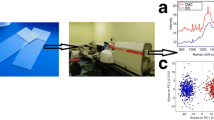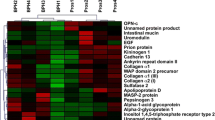Abstract
Vibrational spectroscopy techniques can be applied to identify a susceptibility-to-adenocarcinoma biochemical signature. A sevenfold difference in incidence of prostate adenocarcinoma (CaP) remains apparent amongst populations of low- (e.g. India) compared with high-risk (e.g. UK) regions, with migrant studies implicating environmental and/or lifestyle/dietary causative factors. This study set out to determine the biospectroscopy-derived spectral differences between risk-associated cohorts to CaP. Benign prostate tissues were obtained using transurethral resection from high-risk (n = 11, UK) and low-risk (n = 14, India) cohorts. Samples were analysed using attenuated total reflection Fourier-transform infrared (FTIR) spectroscopy, FTIR microspectroscopy and Raman microspectroscopy. Spectra were subsequently processed within the biochemical cell region (1,800−1–500 cm–1) employing principal component analysis (PCA) and linear discriminant analysis (LDA) to determine whether wavenumber–absorbance/intensity relationships might reveal biochemical differences associated with region-specific susceptibility to CaP. PCA-LDA scores and corresponding cluster vector plots identified pivotal segregating biomarkers as 1,582 cm−1 (Amide I/II trough); 1,551 cm−1 (Amide II); 1,667 cm−1 (Amide I); 1,080 cm−1 (DNA/RNA); 1,541 cm−1 (Amide II); 1,468 cm−1 (protein); 1,232 cm−1 (DNA); 1,003 cm−1 (phenylalanine); 1,632 cm−1 [right-hand side (RHS) Amide I] for glandular epithelium (P < 0.0001) and 1,663 cm−1 (Amide I); 1,624 cm−1 (RHS Amide I); 1,126 cm−1 (RNA); 1,761, 1,782, 1,497 cm−1 (RHS Amide II); 1,003 cm−1 (phenylalanine); and 1,624 cm−1 (RHS Amide I) for adjacent stroma (P < 0.0001). Primarily protein secondary structure variations were biomolecular markers responsible for cohort segregation with DNA alterations exclusively located in the glandular epithelial layers. These biochemical differences may lend vital insights into the aetiology of CaP.

The first study to apply biospectroscopy techniques to identify the underlying differences in the aetiology of prostate cancer between low- (India) compared to high-risk (UK) cohorts






Similar content being viewed by others
Abbreviations
- ATR-FTIR:
-
Attenuated total reflection Fourier-transform infrared
- CaP:
-
Prostate adenocarcinoma
- CZ:
-
Central zone
- E2 :
-
17β-Oestradiol
- FFPE:
-
Formalin-fixed paraffin embedded
- H&E:
-
Haematoxylin and eosin
- IR:
-
Infrared
- LDA:
-
Linear discriminant analysis
- LHS:
-
Left-hand shoulder
- PCA:
-
Principal component analysis
- PCs:
-
Principal components
- PSA:
-
Prostate-specific antigen
- PZ:
-
Peripheral zone
- RHS:
-
Right-hand side
- SNR:
-
Signal-to-noise ratio
- SR-FTIR:
-
Synchrotron radiation FTIR
- TURP:
-
Transurethral resection of the prostate
- TZ:
-
Transition zone
- νasPO −2 :
-
Asymmetric phosphate stretching vibrations
- νsPO −2 :
-
Symmetric phosphate stretching vibrations
- 2D:
-
Two dimensional
- 3D:
-
Three dimensional
References
Cancer Statistics, Incidence-UK, Cancer Research UK (2008) http://info.cancerresearchuk.org/cancerstats/types/prostate/incidence/
Grover PL, Martin FL (2002) The initiation of breast and prostate cancer. Carcinogenesis 23:1095–1102
Hsing AW, Chokkalingam AP (2006) Prostate cancer epidemiology. Front Biosci 11:1388–1413
Grönberg H (2003) Prostate cancer epidemiology. Lancet 361:859–864
Yatani R, Chigusa I, Akazaki K, Stemmermann GN, Welsh RA, Correa P (1982) Geographic pathology of latent prostatic carcinoma. Int J Cancer 29:611–616
Crawford ED (2009) Understanding the epidemiology, natural history, and key pathways involved in prostate cancer. Urology 73:S4–S10
Rastogi T, Devesa S, Mangtani P, Mathew A, Cooper N, Kao R, Sinha R (2008) Cancer incidence rates among South Asians in four geographic regions: India, Singapore, UK and US. Int J Epidemiol 37:147–160
Noel EE, Ragavan N, Walsh MJ, James SY, Matanhelia SS, Nicholson CM, Lu Y-J, Martin FL (2008) Differential gene expression in the peripheral zone compared to the transition zone of the human prostate gland. Prostate Cancer Prostatic Dis 11:173–180
Martin FL, Patel II, Sozeri O, Singh PB, Ragavan N, Nicholson CM, Frei E, Meinl W, Glatt H, Phillips DH, Arlt VM (2010) Constitutive expression of bioactivating enzymes in normal human prostate suggests a capability to activate pro-carcinogens to DNA-damaging metabolites. Prostate 70:1586–1599
Singh PB, Matanhelia SS, Martin FL (2008) A potential paradox in prostate adenocarcinoma progression: oestrogen as the initiating driver. Eur J Cancer 44:928–936
Malins DC, Johnson PM, Barker EA, Polissar NL, Wheeler TM, Anderson KM (2003) Cancer-related changes in prostate DNA as men age and early identification of metastasis in primary prostate tumors. Proc Natl Acad Sci USA 100:5401–5406
Singh PB, Ragavan N, Ashton KM, Basu P, Nadeem SM, Nicholson CM, Krishnan RKG, Matanhelia SS, Martin FL (2010) Quantified gene expression levels for phase I/II metabolizing enzyme and estrogen receptor levels in prostate from high-risk (UK) versus low-risk (India) cohorts for adenocarcinoma at this organ site. Asian J Androl 12:203–214
Baker MJ, Gazi E, Brown MD, Shanks JH, Gardner P, Clarke NW (2008) FTIR-based spectroscopic analysis in the identification of clinically aggressive prostate cancer. Br J Cancer 99:1859–1866
Kelly JG, Maneesh NS, Stringfellow HF, Walsh MJ, Nicholson JM, Bahrami F, Ashton KM, Pitt MA, Martin-Hirsch PL, Martin FL (2009) Derivation of a subtype-specific biochemical signature of endometrial carcinoma using synchrotron-based Fourier-transform infrared microspectroscopy. Cancer Lett 274:208–217
Walsh MJ, German MJ, Singh M, Pollock HM, Hammiche A, Kyrgiou M, Stringfellow HF, Paraskevaidis E, Martin-Hirsch PL, Martin FL (2007) IR microspectroscopy: potential applications in cervical cancer screening. Cancer Lett 246:1–11
Stone N, Kendall C, Smith J, Crow P, Barr H (2004) Raman spectroscopy for identification of epithelial cancers. Faraday Discuss 126:564–573
German MJ, Hammiche A, Ragavan N, Tobin MJ, Cooper LJ, Matanhelia SS, Hindley AC, Nicholson CM, Fullwood NJ, Pollock HM, Martin FL (2006) Infrared spectroscopy with multivariate analysis potentially facilitates the segregation of different types of prostate cell. Biophys J 90:3783–3795
Patel II, Martin FL (2010) Discrimination of zone-specific spectral signatures in normal human prostate using Raman spectroscopy. Analyst 135:3060–3069
Stuart B (2004) Infrared spectroscopy: fundamentals and applications, chapter 7. Wiley, Chichester, pp 137–165
Lin-Vien D, Colthup NB, Fateley WG, Graselli JG (1991) The handbook of infrared and Raman characteristic frequencies of organic molecules, chapter 1. Academic, New York, pp 1–7
Draux F, Gobinet C, Sulé-Suso J, Trussardi A, Manfait M, Jeannesson P, Sockalingum GD (2010) Raman spectral imaging of single cancer cells: probing the impact of sample fixation methods. Anal Bioanal Chem 397:2727–2737
Martin FL, Kelly JG, Llabjani V, Martin-Hirsch PL, Patel II, Trevisan J, Fullwood NJ, Walsh MJ (2010) Distinguishing cell types or populations based on the computational analysis of their infrared spectra. Nat Protoc 5:1748–1760
Beier BD, Berger AJ (2009) Method for automated background subtraction from Raman spectra containing known contaminants. Analyst 134:1198–1202
Trevisan J, Angelov PP, Patel II, Najand GM, Cheung KT, Llabjani V, Pollock HM, Bruce SW, Pant K, Carmichael PL, Scott AD, Martin FL (2010) Syrian hamster embryo (SHE) assay (pH 6.7) coupled with infrared spectroscopy and chemometrics towards toxicological assessment. Analyst 135:3266–3272
Gazi E, Dwyer J, Gardner P, Ghanbari-Siahkali A, Wade AP, Miyan J, Lockyer NP, Vickerman JC, Clarke NW, Shanks JH, Scott LJ, Hart CA, Brown M (2003) Applications of Fourier transform infrared microspectroscopy in studies of benign prostate and prostate cancer. A pilot study. J Pathol 201:99–108
Wehbe K, Pinneau R, Moenner M, Déléris G, Petibois C (2008) FT-IR spectral imaging of blood vessels reveals protein secondary structure deviations induced by tumor growth. Anal Bioanal Chem 392:129–135
Walsh MJ, Hammiche A, Fellous TG, Nicholson JM, Cotte M, Susini J, Fullwood NJ, Martin-Hirsch PL, Alison MR, Martin FL (2009) Tracking the cell hierarchy in the human intestine using biochemical signatures derived by mid-infrared microspectroscopy. Stem Cell Res 3:15–27
Cunha GR, Hayward SW, Wang YZ, Ricke WA (2003) Role of the stromal microenevironment in carcinogenesis of the prostate. Int J Cancer 107:1–10
Tuxhorn JA, Ayala GE, Smith MJ, Smith VC, Dang TD, Rowley DR (2002) Reactive stroma in human prostate cancer: induction of myofibroblast phenotype and extracellular matrix remodeling. Clin Cancer Res 8:2912–2923
Faoláin EO, Hunter MB, Byrne JM, Kelehan P, Lambkin HA, Byrne HJ, Lyng FM (2005) Raman spectroscopic evaluation of efficacy of current paraffin wax section dewaxing agents. J Histochem Cytochem 53:121–129
McNeal JE (1988) Normal histology of the prostate. Am J Surg Pathol 12:619–633
Martin FL (2011) Shining a new light into molecular workings. Nat Methods 8:385–387
Nasse MJ, Walsh MJ, Mattson EC, Reininger R, Kajdacsy-Balla A, Macias V, Bhargava R, Hirschmugl CJ (2011) High-resolution Fourier-transform infrared chemical imaging with multiple synchrotron beams. Nat Methods 8:413–416
Teh SK, Zheng W, Ho KY, Teh M, Yeoh KG, Huang Z (2008) Diagnostic potential of near-infrared Raman spectroscopy in the stomach: differentiating dysplasia from normal tissue. Br J Cancer 98:457–465
Lilja H, Ulmert D, Vickers AJ (2008) Prostate-specific antigen and prostate cancer: prediction, detection and monitoring. Nat Rev Cancer 8:268–278
Acknowledgements
This work was funded by Rosemere Cancer Foundation.
Author information
Authors and Affiliations
Corresponding author
Electronic supplementary material
Below is the link to the electronic supplementary material.
ESM 1
(PDF 409 kb)
Rights and permissions
About this article
Cite this article
Patel, I.I., Trevisan, J., Singh, P.B. et al. Segregation of human prostate tissues classified high-risk (UK) versus low-risk (India) for adenocarcinoma using Fourier-transform infrared or Raman microspectroscopy coupled with discriminant analysis. Anal Bioanal Chem 401, 969–982 (2011). https://doi.org/10.1007/s00216-011-5123-z
Received:
Revised:
Accepted:
Published:
Issue Date:
DOI: https://doi.org/10.1007/s00216-011-5123-z




